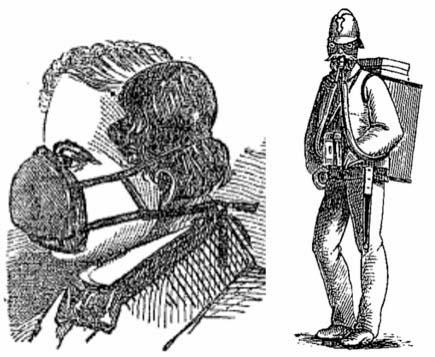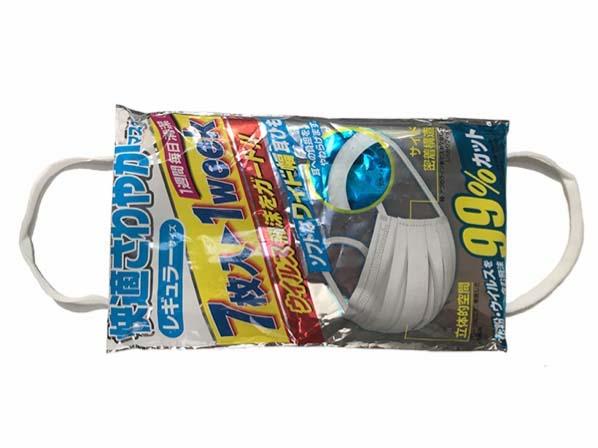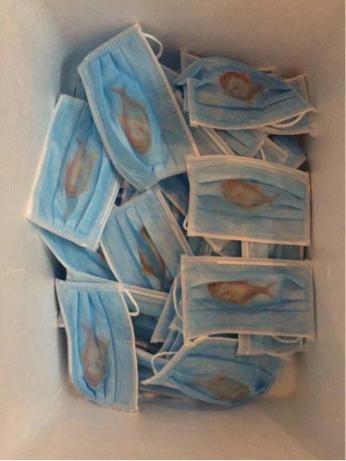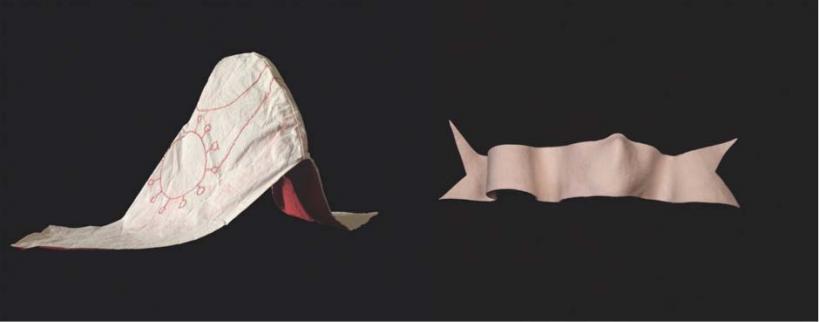The goal is to observe new knowledge, technologies, and materials in the making, follow processes of adaption and invention, and ask how claims of knowledge and technological functionalities are constructed and defended. Striving for geographical breadth though not for universal claims, the project features a growing collection of essays about masks around the globe. The project is enriched by artist interventions and interviews with people who have interacted with the object of desire in a multitude of special ways.
Histories of Masking
Masks and materiality go together, and not only because of their alliteration. The visitor to themaskarrayed.net is greeting by a dazzling collage by Berlin-based artist Regina Maria Möller, who invites the visitor to visually explore shapes, forms, and functions of masks and faces that will later reappear in the individual essay stories. Bringing in their specific expertise and interests, the authors offer both historical perspectives and contemporary observations. Jan Henning, a historian of technology at the University of Toronto, reminds us that masks are some of the earliest artifacts of human history. His essay reflects on the mask’s function as a transformative device and links the development of protective gear to changing perceptions of risk and safety.

Left: Charcoal mask, 1850. Source: Edward L. Youmans, A Class-Book of Chemistry (New York: D. Appleton & Company, 1863), 217. Right: Respiratory apparatus, 1870s. Source: Conrad Dietrich Magirus, Das Feuerlöschwesen in allen seinen Theilen (Ulm, 1877), 173.
Protection, however, can come at the expense of the body. How Koreans both in history and during the current SARS-CoV-19 crisis deal with mask-induced pain is at the center of Jaehwan Hyun’s story. The historian of medicine introduces us to the seafood-harvesting female divers of Korea and Japan, who had find ways to negotiate the pain caused by their swimming goggles. Not goggles, but medical masks in Japan are the topic of Jadie Iijima’s essay. She reflects on the reasons and rituals of wearing medical masks in Japan but also the risks associated with a cultural dependence on masks in non-medical settings.
Treating a mask as an extension of the body allows us to unveil the different layers of functionality that the mask provides for different users, as the gender studies scholar Marianna Szczygielska demonstrates. In order to function, masks need to fit tightly and still be biocompatible, a term that we learn about in her essay on gender and masks. Yet since standardized protective gear needs to be of universal fit, it does not accommodate all body shapes. Developed for predominantly male bodies of soldiers and miners, the respirators fail to account for the feminization of care work in the medical sector where the personal protective gear is most needed at the moment. Rather than neutral objects, the seemingly universal mask becomes a signal for gendered aspects of care work and for vulnerability amidst the pandemic.

Turning a packaged mask into a mask. The text reads “Comfortable fresh masks (regular size) Hygienic all week. Includes 7 pieces → one week. Protects against virus aerosols!! Soft wide ear straps. Softens the stress put upon the ears. Keeps out 99% of pollen/virus particles.” Collage by Jadie Iijima, 2002.
Muffling the Senses
The material extension of our faces not only makes breathing hard—it also changes our sensorial world. Talking, touching, smelling, and tasting all become cumbersome. Noa Hegesh, a historian working on sound, asks how the mask, which affects the mental and physical part of our bodies, are used in order to prevent a disease that itself can lead to a loss of smell and taste. The muffling function of the mask also makes it a symbol for oppression. Long before the pandemic, Vietnamese artists Tran Tuan and Ngoc Tu Hoang created face masks decorated with the image of a fish in order to reach out to communities affected by an environmental disaster in 2016. In an interview for the project, Tuan reflects on this provocative project in the face of the return of the mask as a symbol of a current crisis.

Courtesy of the artist Tran Tuan (2016).
Actual Artifacts: Bringing Materials Online
As the mask as a material object is at the center of the “Mask—Arrayed,” the project has also invited material reflections on the object. Reminiscent of Jan Henning’s argument that masks are artifacts that aid various forms of transformation, such as “good air into bad air,” artists Regina Maria Möller’s and Dinu Bodiciu’s collaborative art project “Exquisite Masking” experimented with virtually exchanging ideas about transforming fabric into masks, which then again transform into headgear. Engaging the craft skills of the reader, Möller also created downloadable DIY “Mask First Aid Kit” that provides a playful twist on the DIY tutorials for so-called community masks.

© Regina Maria Möller/Dinu Bodiciu: “Exquisite Masking, #6 & #1,” 2020.
The Future of the Mask
Are masks here to stay? Or will their use recede into the medical realm and the other specialized work spheres in which they have long been present? Born in highly dynamic times, the “Mask—Arrayed” project is still ongoing and is open to new contributions that comment on historical and contemporary renditions and usages of the mask.
The Mask-Arrayed project is co-led by Carolin Roeder and Marianna Szczygielska. Members of the core team are Noa Hegesh, Jadie Hokuala Iijima Geil, Jaehwan Hyun (all MPIWG), Jan Henning (University of Toronto), and Berlin-based artist Regina Maria Möller. Florian Kräutli, and Robert Casties from the MPIWG Digital Humanities team enabled the technical realization of the “Mask—Arrayed” website.
